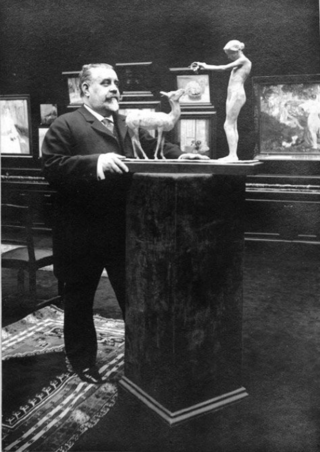
Pierre-Auguste Renoir was a French artist who was a leading painter in the development of the Impressionist style. As a celebrator of beauty and especially feminine sensuality, it has been said that "Renoir is the final representative of a tradition which runs directly from Rubens to Watteau."

The Musée d'Orsay is a museum in Paris, France, on the Left Bank of the Seine. It is housed in the former Gare d'Orsay, a Beaux-Arts railway station built between 1898 and 1900. The museum holds mainly French art dating from 1848 to 1914, including paintings, sculptures, furniture, and photography. It houses the largest collection of Impressionist and post-Impressionist masterpieces in the world, by painters including Berthe Morisot, Claude Monet, Édouard Manet, Degas, Renoir, Cézanne, Seurat, Sisley, Gauguin, and van Gogh. Many of these works were held at the Galerie nationale du Jeu de Paume prior to the museum's opening in 1986. It is one of the largest art museums in Europe.

Maurice Utrillo, born Maurice Valadon; 26 December 1883 – 5 November 1955), was a French painter of the School of Paris who specialized in cityscapes. From the Montmartre quarter of Paris, France, Utrillo is one of the few famous painters of Montmartre to have been born there.

Suzanne Valadon was a French painter who was born Marie-Clémentine Valadon at Bessines-sur-Gartempe, Haute-Vienne, France. In 1894, Valadon became the first woman painter admitted to the Société Nationale des Beaux-Arts. She was also the mother of painter Maurice Utrillo.

Alfred Sisley was an Impressionist landscape painter who was born and spent most of his life in France, but retained British citizenship. He was the most consistent of the Impressionists in his dedication to painting landscape en plein air. He deviated into figure painting only rarely and, unlike Renoir and Pissarro, he found that Impressionism fulfilled his artistic needs.

Jeu de Paume is an arts centre for modern and postmodern photography and media. It is located in the north corner of the Tuileries Gardens next to the Place de la Concorde in Paris. In 2004, Galerie Nationale du Jeu de Paume, Centre national de la photographie and Patrimoine Photographique merged to form the Association Jeu de Paume.

Georges Petit was a French art dealer, a key figure in the Paris art world and an important promoter and cultivator of Impressionist artists.
Claude Roger-Marx, was a French writer, and playwright, as well as an art critic and art historian like his father Roger Marx (1859–1913). He also used the pen name "Claudinet".

Vase with Oleanders was made in 1888 by Vincent van Gogh. The work's location is unknown and it is possibly stolen or possibly destroyed.

Erik Viktor Tryggelin, born 25 June 1878 in Stockholm, died 9 August 1962 in Stockholm, was a Swedish artist, drawer and photographer.
Albert André was a French Post-Impressionist figurative painter. He produced portraits of Pierre-Auguste Renoir, his closest friend, and Claude Monet.

Albert Lebourg, birth name Albert-Marie Lebourg, also called Albert-Charles Lebourg and Charles Albert Lebourg, was a French Impressionist and Post-Impressionist landscape painter of the Rouen School. Member of the Société des Artistes Français, he actively worked in a luminous Impressionist style, creating more than 2,000 landscapes during his lifetime. The artist was represented by Galerie Mancini in Paris in 1896, in 1899 and 1910 by : Galerie Bernheim-Jeune, 1903 and 1906 at the Galerie Paul Rosenberg, and 1918 and 1923 at Galerie Georges Petit.
The Bignou Gallery was a New York City gallery located in Midtown Manhattan. It was a branch of the Bignou Gallery in Paris. The Bignou Gallery exhibited works by major European and American artists including Paul Gauguin, Georges Gimel, Henri Matisse, Jean Lurçat, Antoinette Schulte and Amedeo Modigliani.
Gustav Rau was a German medical doctor, philanthropist and art collector. Rau who was born and died in Stuttgart.

The Seine at Port-Marly, Piles of Sand is an 1875 painting by Alfred Sisley. It was exhibited at the Exposition Universelle in 1900 whilst in the collection of Dr. Georges Viau, a Paris dentist and art collector. By 4 March 1907 it was owned by Durand-Ruel, who tried and failed to auction it on 4 March that year. It was bought by the galerie Bernheim-Jeune in April 1920 and later by Martin A. Ryerson. In 1933 Ryerson left it to its present owner, the Art Institute of Chicago, where it is now in section 201 (Impressionists) on the 1st floor of the Art Institute of Chicago.

After the Bath is a painting from 1910 by the French painter Pierre-Auguste Renoir representing his late work period (1892–1919). The painting is now in the Barnes Foundation in Philadelphia.
Fritz Nathan was a German-Swiss gallery owner and art dealer.
Étienne Bignou was a French art dealer specializing in 19th and 20th century art.

Armand Dorville was a French art collector and lawyer whose art collection was plundered during the Nazi occupation of France.
















